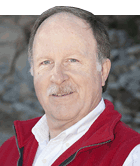It's raining today in big parts of California.
A series of storms began pounding the northern half of the state earlier this week and is expected to last into Monday. But this good news, even when combined with a wet December and a 22 percent cutback in water consumption by California residents, is expected to do little to prevent the state's fourth consecutive year of drought.
That's because January was an awful reminder of how serious its water situation still is: In many parts of the state, last month was the driest January in history.
A stunning example was San Francisco, where, for the first time since records began being kept during the Gold Rush in 1849, zero rainfall was recorded in January. Sacramento got 0.01 inch, the lowest since records began in 1877.
In short, California is still drowning in water problems and the crisis is getting worse, not better, for farmers.
Last November, drought weary and scared voters overwhelmingly passed Proposition 1, a $7.54 billion bond initiative that promised to provide new water supplies, help solve California's drinking water needs, and protect residents from future droughts.
But it will be years before those efforts reach anyone's faucet and, of course, there is already grumbling that a bait-and-switch is happening between campaign promises and actual actions.
So far, spending proposals by governor Jerry Brown include rebates for water-efficient appliance, upgrades to drinking and wastewater treatment plants, water recycling projects, and watershed restoration. But there has been no mention of what agricultural groups say is the crucial must-have in any long-term solution: increased capacity to capture and store rain and snowmelt runoff.
Which is really no surprise at all, because in eco-centric California, "dams" is a four-letter word.
The California Water Alliance (CalWa) is trying to get the message across, though. In a letter it sent to the California Water Commission on Monday this week, it emphasized the irreplaceable importance of taking concrete steps to address the drought problem, saying:
"Water storage – ¬new reservoir storage and groundwater banking ¬– is critical to the state recovering from its historic drought and avoiding the cyclical and certain problems of new drought periods in the future. As the state enters a fourth year of crippling drought, each rainfall that passes and snowmelt occurrence is a lost opportunity to recover or protect from future disaster."
"CalWa urges the California Water Commission to hold tightly the purse strings of Chapter 8 of Proposition 1 and restrict the use of its funds exclusively to build new water storage and fund groundwater banking projects."
It is only a drop in the bucket of what needs to be said and who needs to hear it, but it's a start.

The author has served large Western dairy readers for the past 37 years and manages Hoard's WEST, a publication written specifically for Western herds. He is a graduate of Cal Poly-San Luis Obispo, majored in journalism and is known as a Western dairying specialist.
A series of storms began pounding the northern half of the state earlier this week and is expected to last into Monday. But this good news, even when combined with a wet December and a 22 percent cutback in water consumption by California residents, is expected to do little to prevent the state's fourth consecutive year of drought.
That's because January was an awful reminder of how serious its water situation still is: In many parts of the state, last month was the driest January in history.
A stunning example was San Francisco, where, for the first time since records began being kept during the Gold Rush in 1849, zero rainfall was recorded in January. Sacramento got 0.01 inch, the lowest since records began in 1877.
In short, California is still drowning in water problems and the crisis is getting worse, not better, for farmers.
Last November, drought weary and scared voters overwhelmingly passed Proposition 1, a $7.54 billion bond initiative that promised to provide new water supplies, help solve California's drinking water needs, and protect residents from future droughts.
But it will be years before those efforts reach anyone's faucet and, of course, there is already grumbling that a bait-and-switch is happening between campaign promises and actual actions.
So far, spending proposals by governor Jerry Brown include rebates for water-efficient appliance, upgrades to drinking and wastewater treatment plants, water recycling projects, and watershed restoration. But there has been no mention of what agricultural groups say is the crucial must-have in any long-term solution: increased capacity to capture and store rain and snowmelt runoff.
Which is really no surprise at all, because in eco-centric California, "dams" is a four-letter word.
The California Water Alliance (CalWa) is trying to get the message across, though. In a letter it sent to the California Water Commission on Monday this week, it emphasized the irreplaceable importance of taking concrete steps to address the drought problem, saying:
"Water storage – ¬new reservoir storage and groundwater banking ¬– is critical to the state recovering from its historic drought and avoiding the cyclical and certain problems of new drought periods in the future. As the state enters a fourth year of crippling drought, each rainfall that passes and snowmelt occurrence is a lost opportunity to recover or protect from future disaster."
"CalWa urges the California Water Commission to hold tightly the purse strings of Chapter 8 of Proposition 1 and restrict the use of its funds exclusively to build new water storage and fund groundwater banking projects."
It is only a drop in the bucket of what needs to be said and who needs to hear it, but it's a start.

The author has served large Western dairy readers for the past 37 years and manages Hoard's WEST, a publication written specifically for Western herds. He is a graduate of Cal Poly-San Luis Obispo, majored in journalism and is known as a Western dairying specialist.







